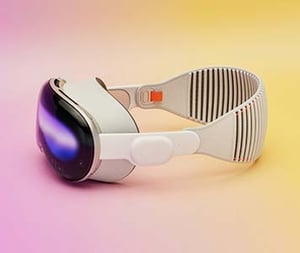The patent strategy behind Apple Vision Pro unravelled by EP&C
 At the beginning of this month Apple launched its first 'spatial computer'. With the Apple Vision Pro the company immediately significantly raised the bar for virtual reality (VR) headsets because the device is much more than that, it combines VR and augmented reality (AR), blurring the boundaries between the virtual and physical worlds. In this article, Simon Van Mierlo, a trainee patent attorney at EP&C, takes a look at the patent strategy used by Apple during the development of this device. What conclusions can we draw from this strategy? And what important lessons can tech start-ups and scale-ups learn from this?
At the beginning of this month Apple launched its first 'spatial computer'. With the Apple Vision Pro the company immediately significantly raised the bar for virtual reality (VR) headsets because the device is much more than that, it combines VR and augmented reality (AR), blurring the boundaries between the virtual and physical worlds. In this article, Simon Van Mierlo, a trainee patent attorney at EP&C, takes a look at the patent strategy used by Apple during the development of this device. What conclusions can we draw from this strategy? And what important lessons can tech start-ups and scale-ups learn from this?
The Apple Vision Pro: a unique mixed reality experience
The Apple Vision Pro is an advanced mixed reality headset that lets Apple seamlessly blend the virtual and physical worlds.
Apple launched the Apple Vision Pro in the US on 2 February. In doing so, the US technology giant is entering a new era. Admittedly a little later than competitors such as Samsung, Sony or Meta, but with an edge over these players. Because whereas earlier headsets focus heavily on realistic virtual reality, the Apple Vision Pro is an advanced mixed reality headset that lets Apple seamlessly blend the virtual and physical worlds.
The device uses augmented reality (AR) and virtual reality (VR). The glasses have advanced features which include projecting digital images into the physical world and creating virtual screens that can be operated by users’ fingers, eyes, and voice.
The company is also introducing a unique application where users’ eyes are displayed on the outside of the display. This enhances the connection with the surrounding world while the users enjoy a state-of-the-art AR experience.
Apple's patent strategy
The launch of the glasses was preceded by over 15 years of research and development. Needless to say, Apple took the necessary steps to protect the innovative technologies of its new headset. Simon Van Mierlo, a trainee patent attorney at EP&C, analysed the patents associated with the Apple Vision Pro.
What can smaller tech start-ups and scale-ups learn from this strategy? And how can they use it to position themselves more strongly in the market? Simon is happy to explain.
A patent for each individual technology
In this case there is not a single patent to protect a single product but each underlying, innovative technology is protected separately.
"The first, most obvious conclusion is that Apple protects the technologies present in the product separately," Simon explains.
"So it is not about a single patent for a single product but about protecting each underlying, innovative technology separately. For example, eye tracking and object recognition technology are protected separately. The same applies to how the glasses are attached to a user's head, the adjustability of the headset and the lenses. The technologies that determine where the glasses are located in the environment, that limit the user's movement in the virtual world, that enable the display of content inside the glasses and so on, are also patented separately."
Core patents for core technology first
Another conclusion that Simon draws is that Apple initially strategically focused on key, core patents within a specific technology of the Apple Vision Pro. It only filed patent applications for additional, broader and further innovations after that.
"From my analysis it appears that the trend changed over the years. Between 2008 and 2012 we see only five core patents for the same number of different core technologies: object recognition (2008), spatial computing: positioning in environment (2010), spatial computing: display of content (2011), eye tracking (2011), and spatial computing: control (2012).
On the whole, the main focus is very much on the display of content or the creation of the virtual environments. In recent years this has also shifted towards the construction of the glasses, both the head mount and the optical elements such as the lenses."
Core technologies from smaller players
Core technologies and associated patents have been developed and obtained by smaller players.
Further analysis reveals that a significant proportion of these core technologies and associated patents have been developed and obtained by smaller players other than Apple.
"The eye tracking technology, for example, was developed by SensoMotoric Instruments and subsequently transferred to Apple (2011: EP2499960 B1). The same applies to Metaio Gmbh, which developed the spatial computing technology that Apple uses in the Vision Pro (2011: EP2542957 B1, 2010: EP2356583 B1 and others). Akonia Holographics, which developed the protected, optical technology for the glasses' lenses, was also acquired by Apple (2017: EP3420396 B1). It is possible to access this information free of charge via Espacenet for instance."
Strategically focusing on core patents creates value for smaller players
By protecting core technologies, a big player like Apple simply cannot get around you and you increase the value of your innovation and your business.
What key lessons can tech start-ups and scale-ups take away from this analysis? First of all, big players need smaller ones to develop and market their technology and product. According to Simon, this presents a major opportunity for tech start-ups and scale-ups. Because many of these companies, and the entrepreneurs behind them, aim to cash in on the value of their technology at some point.
"In addition, Apple's patent strategy teaches us that smaller technology companies create the most value by strategically focusing on developing one specific sub-technology and protecting it with a patent. If you protect that core technology, a big player like Apple simply cannot get around you and you increase the value of your innovation and your company."
Are you a tech start-up or scale-up? Are you working on developing an innovative technology and do you have questions about protecting it? If you want to know how a patent puts your innovation and company in a stronger position in the market then please contact Simon Van Mierlo at simon.vanmierlo@epc.be and book an appointment.

About the author
I joined EP&C in 2020, after earning a Ph.D. in computer science and conducting research as a post-doc. I love translating complex innovations into meaningful intellectual property. My technical...
More about Simon >